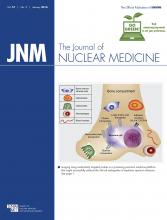Article Figures & Data
Tables
Biologic agent Trial phase Identifier Condition Target Principal investigator Sponsor Bevacizumab-IRDye800CW I NCT01691391 FAP VEGF W.B. Nagengast University Medical Centre Groningen Bevacizumab-IRDye800CW I NCT01972373 Rectal cancer VEGF W.B. Nagengast University Medical Centre Groningen Bevacizumab-IRDye800CW I NCT01508572 BC VEGF G.M. van Dam University Medical Centre Groningen Bevacizumab-IRDye800CW I NCT02129933 Premalignant esophageal lesions VEGF W.B. Nagengast University Medical Centre Groningen Cetuximab-IRDye800CW I NCT01987375 HNC EGFR E.L. Rosenthal UAB Panitumumab-IRDye800CW P NCT01998273 HNC EGFR E.L. Rosenthal UAB MDX1201-A488 P NCT02048150 PCa PSMA T. Wilson City of Hope Medical Center ProstaFluor O NCT01173146 PCa PSMA D. Herrell Spectros Corp. AVB-620 I NCT02391194 BC Proteases A. Wallace Avelas Biosciences BLZ-100 I NCT02234297 Glioma brain tumors MMP-2 C.G. Patil Blaze Bioscience Inc. Annexin VII 5-ALA I NCT00870779 HGG, meningioma, pituitary adenoma, or metastasis Porphyrin D.W. Roberts Dartmouth-Hitchcock Medical Center Synthesis K. Paulsen 5-ALA II NCT01445691 Brain tumors Porphyrin C. Hadjipanayis Emory University Synthesis 5-ALA I NCT01128218 Brain tumors Porphyrin J.W. Cozzens Southern Illinois University II Synthesis 5-ALA O NCT01837225 BC Porphyrin W.L. Leong UHN, Toronto Synthesis R.S. DaCosta 5-ALA II NCT00752323 Brain tumors Porphyrin A. Sloan Case CCC Synthesis 5-ALA I NCT02191488 Brain tumors Porphyrin D.W. Roberts Dartmouth-Hitchcock Medical Center Synthesis 5-ALA III NCT01502280 Glioblastoma Porphyrin N. Sanai St. Joseph’s Hospital and Medical Center Synthesis 5-ALA O NCT02155452 Glioblastoma Porphyrin A.V. Moiyadi Tata Memorial Hospital Synthesis LUM015 I NCT01626066 Sarcoma, BC Cathepsin D. Kirsch Duke University Medical Center FAP = familial adenomatous polyposis; VEGF = vascular endothelial growth factor; BC = breast cancer; HNC = head and neck cancer; EGFR = epidermal growth factor receptor; UAB = University of Alabama at Birmingham; P = pilot; PCa = prostate cancer; O = observational; HGG = high-grade glioma; UHN = University Health Network; CCC = Comprehensive Cancer Center.
Registered ongoing clinical trials as of July 16, 2015.
Recommendation Summary 1 • Microdosing can be used to confirm target specificity but is insufficient for intraoperative imaging. 2 • It is currently unclear if the device and the drug product should be paired or general parameters for devices set for each drug product. Discussions during a pre-IND meeting or during a subsequent meeting with FDA (such an end of phase 2 meeting) should address combination product development considerations. However, it is preferable for device manufacturers to seek marketing approval without restriction of the device to any specific optical imaging agent if the device can successfully image more than 1 fluorophore within the device’s excitation/emission spectrum. 3 • Dose- and time-ranging studies should be performed in phase I clinical trial setting. A dose-escalation study designed to detect optimal imaging contrast during surgery as well as safety is generally preferred over a trial design or dosing schedule intended solely to assess imaging agent safety. 4 • Considering the multiple indications optical imaging agents may ultimately be approved for, the common verification for a cancer indication should be demonstration that the imaging successfully delineates normal from abnormal tissue. There is a consensus that a standard methodology should be introduced to accomplish the correlation of fluorescence with the presence of tumor. 5 • The general consensus is that in order for optically guided surgery to advance to routine clinical use, there must be a widely adopted methodology for fluorescence assessment. This degree of standardized and objective assessment will be helpful for regulatory approval to critically demonstrate the ability of the technique to provide disease-specific contrast. 6 • Acceptable toxicity for optical contrast agents for oncologic surgery should be between diagnostic and therapeutic agents. 7 • Grade 2 toxicity in 20% of the population is an acceptable threshold as a dose limiting toxicity.







